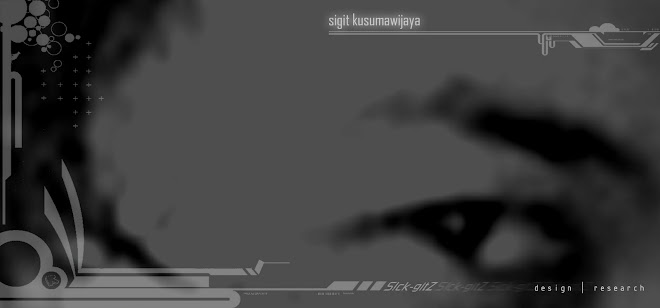This is a synopsis of the introductory presentation for the videography project: Where R Ur Empathies, Jakartans? “urban distortion phenomenon of Jakarta in design perspective” [:campaign project] -- an initiative urban campaign project to critize the urban phenomenon of Jakarta. With his colleague, Priyanto under the team called urbVIZ [:studio] or Urban Visualization Studio, Sigit tried to describe what "empathy" is and why we should empathize others.
"Empathy"

- the identification and understanding of another’s situation and feelings
- the action of being sensitive to another person’s experience and feelings
- understanding and entering into another person’s feelings
 While the ability to imagine oneself as another person is a sophisticated imaginative process which only fully develops later on in life, the roots of this ability are probably innate.
While the ability to imagine oneself as another person is a sophisticated imaginative process which only fully develops later on in life, the roots of this ability are probably innate.Human capacity to recognize the emotions of others are related to our imitative capacities, and seem to be grounded on the innate capacity to associate the bodily movements and facial expressions we see, with the proprioceptive feelings of those same movements or expressions.
 Humans also make the same immediate connection between the tone of voice and inner feeling. Hence by looking at the facial expressions or bodily movements of others, or hearing their tone of voice, we are able to get an immediate sense of how they feel on the inside.
Humans also make the same immediate connection between the tone of voice and inner feeling. Hence by looking at the facial expressions or bodily movements of others, or hearing their tone of voice, we are able to get an immediate sense of how they feel on the inside.We experience this as directly seeing their emotion (say sadness or anger) not just the behavioral symptoms of that emotion.
 One must be careful not to confuse empathy with sympathy, which is a distinct social emotion characterized by a general pro-attitude towards another person and their goals.
One must be careful not to confuse empathy with sympathy, which is a distinct social emotion characterized by a general pro-attitude towards another person and their goals.empathy can affect sympathy
 Some experts (psychologist, scientist, psychiatrist) believe that not all humans have an ability to feel empathy or perceive the emotions of others. For instance, Autism and Asperger's syndrome are often characterized by an inability to empathize with others.
Some experts (psychologist, scientist, psychiatrist) believe that not all humans have an ability to feel empathy or perceive the emotions of others. For instance, Autism and Asperger's syndrome are often characterized by an inability to empathize with others. Even more, People can empathise with animals.
Even more, People can empathise with animals.As such, empathy is thought to be a driving psychological force behind the animal rights movement (an example of sympathy), whether or not using empathy is justified by any real similarity between the emotional experiences of animals and humans.

just try to do these simple things:
See what other sees
Hear what other hears
Feel what other feels
See what other sees
Hear what other hears
Feel what other feels
another link in Sigit Kusumawijaya Multilpy site:
JKT urban-cinematography [:project] >>>03 Presentation about "Empathy": http://sigitkusumawijaya.multiply.com/photos/album/5
This project has been presented on Belajar Desain [Design Learning] Gathering #22 on 24 Februari 2006. The documentations can be found in this link: http://groups.yahoo.com/group/belajardesain/photos/album/2082583944/pic/list
Work Description:
Title: Empathy [introductory presentation for the videography project: Where R Ur Empathies, Jakartans?]
Presenter: Sigit Kusumawijaya
Team: Sigit Kusumawijaya & Priyanto
Year: 2006
Achievement:
* Entry for OK Video 2006, International Video Competition held by Ruang Rupa, Jakarta
* Presented and exhibited on Open House Arsitektur UI, Januari 2006, Jakarta
* Presented on Belajar Desain [Design Learning] Gathering #22, 24 Februari 2006, Jakarta
* Presented on Forum of Indonesian Young Architect (Forum Arsitek Muda Indonesia/AMI), Jakarta
* Published on OUTMAGZ Magazine vol.13//April 2006//COLOR on page 58-61














